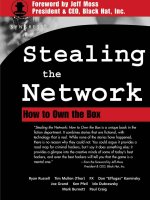stealing the network how to own the box PHẦN 2 pptx
Bạn đang xem bản rút gọn của tài liệu. Xem và tải ngay bản đầy đủ của tài liệu tại đây (538.48 KB, 33 trang )
Hide and Sneak • Chapter 1 11
HELP, EXPN, and VRFY available to me.That’s a lot of information to just
give out. So, I could access the mail port, but I really wanted telnet access. I
moved on to the Web servers.
The Web, the Web …
It’s Always the Web
The Web servers proved more worthwhile, as far as access was concerned.
Initial scans indicated that the only two ports open to the Internet on these
two servers were 80 and 443 (HTTP and HTTPS, respectively). I knew that
they were watching port 80 because none of my Whisker scans were suc-
cessful on either server.The SSL port provided a plethora of information.
See, that’s the beauty of SSL: It hides things from the IDSs.They can’t see
into the data stream, because the data stream is encrypted. Isn’t that lovely?
So to get the scans of their SSL servers, I had to set up an SSL tunnel
and then use that to conduct my scans.That’s easy enough to do with one of
the tools in my toolbox called—big surprise—SSL Proxy.
SSL Proxy (sslproxy) is a neat little program that basically lets you con-
nect to an SSL server (or something else that uses SSL) and communicate
with it normally. SSL Proxy handles all the necessary encryption for you.To
use it, you just point it to the remote SSL server and bind it to a local port
on your box, telnet to that port, and you’re in.
SSL Proxy to Windows 2000 Web Server
www.syngress.com
249_StealThis_01.qxd 4/18/03 6:20 PM Page 11
12 Chapter 1 • Hide and Sneak
From the screen, I could tell that I wasn’t the first one to show up at this
machine. Apparently, someone else hacked into it and changed the default
page on the SSL server. Oh well, no matter.That didn’t deter me. But it was
kind of funny that the sysadmin hadn’t figured out that someone else owned
this box. My guess is that it wasn’t that important of a system for them. For
me, it meant a way in. Once I had verified that I could scan the Web server,
I let Whisker go through its paces, and what do you know? This box was
also open to a whole variety of Internet Information Server (IIS) vulnerabili-
ties.You would think the admins would at least patch it somewhat! Still, the
easiest thing to do would be to choose an exploit and go with it.The one I
went with was the Microsoft IIS directory traversal vulnerability and its pop-
ular exploit, iis-zang.
Still using the SSL Proxy tunnel I had set up, I connected to the Web
server and began looking around. Apparently, the guys who hacked this box
before me left behind the tools of their trade.
Tools of the Trade
www.syngress.com
249_StealThis_01.qxd 4/18/03 6:20 PM Page 12
Hide and Sneak • Chapter 1 13
They left behind plenty of things for me to use myself. But, in order to
get to that Solaris box behind the router, I was going to need to go even
further than they had.This would be a bit tricky, but if it worked, it would
be quite sweet.
So, what to do with the remnants left by my apparent predecessors on
this system? Well, I figured why waste their work? So I used the pwdump tool
to dump the local system SAM. I figured out that their nc1.exe was basically
netcat. In order to get around some minor limitations in the Microsoft vul-
nerability that I was exploiting, I decided to make use of the nc1.exe pro-
gram my “friends” left behind. One problem though: the router ACL. How
to get around that? Well, since I couldn’t connect into them, why not have
them connect to me? That’s exactly what I did. I set up netcat on my
system, and then used the nc1.exe program to connect into my listening
netcat process. It’s not called the “Swiss army knife for networks” for no
reason. Setting up my netcat listener on port 5000, I then used the netcat
on the Windows host to connect in. Apparently, they were not filtering on
the outbound traffic; shame on them.This can be so much fun!
Instant Command-Line Access
www.syngress.com
249_StealThis_01.qxd 4/18/03 6:20 PM Page 13
14 Chapter 1 • Hide and Sneak
Now, this provided me with a better command-line interface. I then used
the pwdump.exe program to dump the host SAM, which might come in
handy. I dumped the host SAM and downloaded the output to my system,
where I could run it through John the Ripper to crack some passwords. I
cracked several passwords almost immediately, including one called master.
Interesting.
My goal was not the Windows host that I had accessed, but rather the
Sun mail server.The first step was to find some accounts on that system.To
do this, I would need to tunnel through the Windows host to reach ports on
the Sun host, from inside the router. I know about another neat little pro-
gram called httptunnel (and its Windows counterpart, hypertunnelNT), which
would let me do just that. I uploaded hts.exe (along with the necessary
cygwin1.dll) from the hypertunnelNT software package to the Windows host
using TFTP. I then set up the server side of the HTTP tunnel with this com-
mand:
c:\inetpub\scripts\hts.exe –F 10.89.144.241:79 443
Basically, this forwards port 443 (and, subsequently, knocks off the SSL
server from that port) to the host 10.89.144.241 TCP port 79 (finger).Then,
on my host, I set up the “client” end of the tunnel:
[root@tethys:httptunnel-3.0.5] ./htc –F 79 10.89.144.166:443
This forwards my local port (TCP port 79, again finger) to the Windows
server box 10.89.144.166 on the SSL port. I had to hope that their IDS
didn’t have any signatures for traffic destined to port 443 (since that is typi-
cally encrypted). Once that was done, I simply used the finger program on
my localhost, and it was forwarded to their Sun system’s finger port. In my
mind, I could picture what was going in. It’s actually pretty neat.
www.syngress.com
249_StealThis_01.qxd 4/18/03 6:20 PM Page 14
Hide and Sneak • Chapter 1 15
Tunneling through a Routers ACLs
Now, Sun has had a few bugs in their finger program. One of them
involves using a long argument to the finger program.This argument can be
used to trigger the bug:
a b c d e f g h i j k l m n o p q r s t u v w x y z
This causes finger to return a list of all user accounts on the system, not
just those logged on at the time. Using the following command causes the
host being fingered to dump all of its user account information:
[idubraws@tethys idubraws] finger “a b c d e f g h i j k l m n o p q r s
t u v w x y z”@localhost
And there it is on my screen.
Account Information on a Sun SMTP Host
www.syngress.com
microsystems
?
htc -F 79 10.89.144.166:443
hts.exe -F 10.89.144.241:79 443
2
1
Sun SMTP Server
Windows 2000
Web Server
249_StealThis_01.qxd 4/18/03 6:20 PM Page 15
16 Chapter 1 • Hide and Sneak
With the account information, I now needed to point the tunnel to the
Sun’s telnet port and simply try some of the accounts.The account named
master that I had seen before on the Windows host seemed like a good start,
especially since I already had a password for that account. It would be inter-
esting to see if that account carried over to this system.
Telnet Access to Sun SMTP Host
And it did. Now I had a real system to work with. What I needed to do
was find a local exploit against that system, get root access, and then go to
work on the SSH host to get complete access through a more “direct”
channel.
Root access to the Sun workstation was achieved through a local exploit
called netprex.This little exploit takes advantage of a bug in the netpr pro-
gram, which is part of the Solaris printing facility. Once I achieved root
privileges, I grabbed the passwd and shadow files for cracking by John the
Ripper. John didn’t take very long to crack the root password to the Solaris
SMTP host.The next thing to do was find an account on the SSH host, get
access, and then come in through the front door.
www.syngress.com
249_StealThis_01.qxd 4/18/03 6:20 PM Page 16
Hide and Sneak • Chapter 1 17
KISS, or Keep It Simple, Stupid
One of my professors in aerospace engineering used to tell us that we should
always keep our designs simple.The easiest solution is the simplest one. He
had it down to four letters: KISS, for Keep It Simple, Stupid. Having learned
my lesson, I decided to try the simplest thing first. I’ll telnet to the SSH host
and see what it is. And guess what I got!
Out through the In Door
It was an OpenBSD system. Very nice, but it gets even better.The very
same account that gave me access to the Solaris mail server also provided
access to the SSH server. I didn’t get root on this system, but who needed
that when I had access to this host from the outside? I could now use SSH
to access this host as the user master and not need to rely on any tunneling
methods to get around the router ACLs. It was getting late, and I had to go
to work.
The Jackpot
I came back home from work the next morning and decided that further pene-
tration into the target network could wait until I caught up on some sleep.
Third shift sucks, but hey, it pays the bills. When I got up that afternoon, I
www.syngress.com
249_StealThis_01.qxd 4/18/03 6:20 PM Page 17
18 Chapter 1 • Hide and Sneak
decided to keep going with my little “project.” I sat down in front of the
computer, turned on some music (I prefer Beethoven’s Ninth Symphony for
this kind of work), grabbed a Coke, and focused on the OpenBSD host.
After connecting in through the OpenBSD server with SSH, I started
looking around. Just as I thought, the really good stuff— the Web servers and
database hosts—was at the data center. But, like all companies that do this
kind of work, I figured that they probably had some database systems on
their corporate network where the development boys did their work. And
most likely, those databases had live data. I’d seen it before; it’s not like they
would be the first to do that. A little poking around gave me my answer.The
Web server was also running a Microsoft SQL database. Even better was that
I discovered that it was also running Microsoft Terminal Services. Getting
access was easier this time, because I just used SSH forwarding to forward my
local port TCP/3389 to the Web server’s Terminal Server port when I con-
nected in to the SSH server.To access the terminal server from Linux, I used
the rdesktop Linux client.
www.syngress.com
249_StealThis_01.qxd 4/18/03 6:20 PM Page 18
Hide and Sneak • Chapter 1 19
SSH Tunneling to Microsoft Terminal Server
Access to Microsoft Terminal Server
I figured, what the hell, I’ll try some of the passwords I have to see if I
can gain access to the box. Sure enough, the admin password I cracked the
day before worked like a charm. Once I gained access to that host, I poked
around to find the database.The Microsoft SQL client was installed on that
host anyway, and it didn’t take me long to get access there either.This was
something very much worth my while.
One thing I have to say about MS SQL is that you can really have fun
with it. I had to figure that they did a default install on this system. I mean,
come on, it’s internal to their network, they’ve got this stuff behind a router
with ACLs, so who wouldn’t think that this thing is safe? Well, with a default
install, the sa account doesn’t get a password.You can use some tools to gain
access to the SQL Server (I couldn’t find a Linux box to run LinSQL or
SLAT), but there’s just no substitute for good, old SQL commands you craft
yourself.
All I can say is the information in that database was worthwhile. I found
plenty of credit card numbers, customer names, addresses, social security
numbers, and other interesting stuff. I figured this was worth sharing with
www.syngress.com
249_StealThis_01.qxd 4/18/03 6:20 PM Page 19
20 Chapter 1 • Hide and Sneak
my friends. Perhaps next time, these guys will be a little nicer to their cus-
tomers when they have a problem and be more willing to help out.
With Customers Like Me…
You certainly don’t need enemies.The credit card information in the
database was worth its weight in gold. So I announced to my “select” friends
on IRC what I had. Boy, you know, some of these people wouldn’t give me
the time of day before. Now, it’s,“Hey, buddy, how ya’ doin?” and “What’s
up, friend?” I didn’t care that much about their respect. I was more interested
in getting a little “justice.” I bet someone over there got their butt chewed
out big time when they found my little escapade.
About two days after I went in on my little romp through their house, I
suddenly noticed that the OpenBSD box was no longer there and the
Microsoft Web servers were patched. Hmmm… wish I was a fly on the wall
of the office of the IT guys over there.
www.syngress.com
249_StealThis_01.qxd 4/18/03 6:20 PM Page 20
The Worm Turns
by Ryan Russell and Tim Mullen
Here we go.
I wander down the hall to tell my wife that I’ll be
working all night. She tells her friend on the phone to
hold on a sec.
“Why? What happened?” she says.
“A new worm,” I say.
“Aw crap, not again. Is it a big one?”
“I don’t know. I’ll have to look at it first.”
She tells her friend that I’m going to be up all
night, and that I’ll probably be useless tomorrow. I hear
her voice trail off as I wander back down the hall to
my home office.
Chapter 2
21
249_StealThis_02.qxd 4/18/03 5:28 PM Page 21
22 Chapter 2 • The Worm Turns
Whenever someone asks me what I do for a living, and I know they
really don’t care, I tell them “computer stuff.” If that’s not enough for them, I
clarify with “computer security stuff—hackers, viruses, worms….”About
then, their eyes glaze over, and I can stop explaining. If it’s someone in my
field of work, I tell them I do malicious code analysis, vulnerability analysis,
IDS signatures, tool development, and computer forensics.That’s enough to
satisfy them. Rarely do people like me want to chitchat about what we do in
general terms. We live in a world of minute detail, machine-language code,
operating system calls, and compiler quirks. Most of the time, we would
rather keep to ourselves and do independent study, unless we’re having
trouble with something specific or want someone to double-check our
work.
One kind of event that tends to cause a lot of interaction is a new worm
breakout. For someone who does computer security for a living, there’s very
little more exciting than a new worm.This is especially true if it’s a particu-
larly “successful” one. A worm hits all the key buttons that fascinate a guy
like me: exploits, binary analysis, packet captures, networking, and most of all,
media coverage.
If you can be the first to capture a worm, analyze a worm, and name a
worm, there’s a good chance you’ll get some media coverage out of it.
Reporters will want to interview the guy who discovered the thing. In the
computer security field, it pays to have brand recognition.You want your
peers to know your name on sight. It will get your opinion respected and
probably help you get the job you want.
When there’s a big worm, everyone will be working on it, and everyone
will (shortly) have a copy.That means there’s a time limit.That means all-
nighters. It’s very much a race for first. But, you know, that’s really not a
problem for me. I love doing disassembly. I don’t even miss the sleep for the
first 20 hours or so. After that, I’m usually done (well, done enough), or I
need to grab a few hours before I start again. I’m past 30 years old— too old
to go 48 hours anymore.
Sometimes, you can use a small team to do the work, but more often
than not, working with other people just slows things down. Managers who
manage the techies think that the product of such work is an analysis docu-
ment—a piece of paper (well, a Word file).That’s not it at all; what you’re
trying to do is not get it down on paper, but rather get it in your head. Once
www.syngress.com
249_StealThis_02.qxd 4/18/03 5:28 PM Page 22
www.syngress.com
you have it in your head, it’s trivial to get it back out and onto paper. Well,
maybe after a few hours sleep, it is.
The problem with disassembling something is that the pieces often don’t
make any sense until the other pieces make sense.You can take a nice, short
piece of machine code, and you really have no idea what it’s doing until you
know exactly what variables are passed to it and what happens to them
before and after the function you’re examining. It’s like a crossword puzzle.
When you have a clue you’re looking at for an “across” word, you have a few
guesses as to what it might be. Several of the words you can think of will fit
in the number of letters you have.You’ll have no idea if you have the right
word until you get all the “down” words that intersect it. Of course, you
won’t know for sure you’ve got the right down words until you’ve got the
across words to go with them.
I do my disassembly work in IDAPro.That shouldn’t be too much of a
surprise. Everyone does their disassembly work in IDAPro, which is why I do.
That, and because it’s the best disassembler I’ve ever used. If I did prefer
something else, it wouldn’t make a lot of difference. If you need to trade dis-
assembled code with someone, you trade IDB files, which is the file format
IDAPro uses. If I ever need to trade disassemblies with an AV company, that’s
what they use. If you ever see someone’s cut-and-paste of a disassembly
they’ve done, you’ll see that they used IDAPro. It’s like Word in that respect.
You may not like Word or even Windows, but if you do any writing for a
living, you’ll use Word.
Mr. Worm
But before you can dissect a worm, you need to have a copy—like the one I
got 23 minutes ago. If it’s a really good worm, everybody gets a copy.The
ones that spread via e-mail are easy.The ones that attack Web servers and
such require a little more work, but not much. Once you know a worm is
there, you just need to set up the proper monitoring tools, and a copy will
deliver itself to you shortly.
Things like viruses,Trojan horses, and rootkits are a bit harder to come
by, because they don’t necessarily try to deliver themselves to every machine
in the world. If you want to be early with one of those, usually you’ll need
someone to hand you a copy. If you’re lucky, someone will post to a mailing
list that they’ve got something they’ve never seen before, and their AV soft-
The Worm Turns • Chapter 2 23
249_StealThis_02.qxd 4/18/03 5:28 PM Page 23
24 Chapter 2 • The Worm Turns
ware doesn’t report anything weird. Usually, those people are more than
happy to hand over a copy to a “professional” to take a look at and tell them
what it is and how badly they’ve been screwed.
Other times, various AV companies are the only ones who seem to have
a copy.They’re a bitch to deal with; it’s a classic old-boys’ network. Officially,
they only deal with other AV companies.They want to impose restrictions
on who you can share with, and so on. If any of them think you’re spreading
code where you shouldn’t, you get blackballed.That’s officially. It turns out
that if you make a few special friends in the tech groups of these same com-
panies, you can keep your supply lines open.They just want copies of the
malicious code, too. A small percentage of time, I’m the first one to get a
copy. I make sure to send a copy to a few friends, and then later when I ask
them for a favor, they won’t ignore me. It gives them the edge over their
competitors. Everyone wants to be first.
It’s not just raw, malicious code that I trade, either. I also trade disassem-
blies. Some of these AV guys are incredibly good at doing disassemblies; they
put me to shame.They have special tools that they’ve developed in-house
over the years, too. And you can’t get copies of those. For example, do you
need to disassemble compiled Visual Basic 5 or 6? Too bad—you can’t find
any good tools to do that.The AV guys have them, though, written in-house.
They aren’t sharing the tools, either. I had originally assumed that they could
completely kick my ass at disassembling any given worm and would have no
use for my skills. But that’s not exactly true.
See, the AV guys have to deal with a huge volume of malicious code.
First off, they have signatures for what, like 50,000 viruses and such? And
they’re doing around 3,000 new ones per year? That means they need to be
able to detect it, clean it, and move on. Add to that all the false alarms their
customers mail them all day long. If people don’t know what files are, they
just mail them to their AV vendor, and someone has to check out those files.
Me? I do about a dozen worms per year. I don’t get anywhere near as
much practice as the AV guys do that way, but I can do a more thorough
job. I can spend a whole week refining what I know about a worm, after my
initial hurried analysis. What else is weird is that the AV guys and I care
about totally different parts of the worms. I really couldn’t care less about the
piece of code that infects .exe files. Once I know which bit of code does
that, I name it as such, and move on. What I want to know is what vulnera-
www.syngress.com
249_StealThis_02.qxd 4/18/03 5:28 PM Page 24
The Worm Turns • Chapter 2 25
bilities the thing uses, whether it leaves backdoors, what the command
channel is, what IRC server(s) it uses—that kind of thing.The AV guys are
all about the file infector pieces—how to spot it on disk, how to disinfect an
infected file—which is stuff I don’t care about.
Nimda is a good example. Heh, Nimda is a good example for just about
anything having to do with worms. Nimda has its worm parts: does the tra-
ditional Web attacks, e-mails itself, and even goes after file shares.Those are
the parts I want. I need to write Snort signatures for those kinds of things.
Oh yeah, and Nimda infects files, too.That’s the part that makes the AV guys
perk up.
So, the point is that my disassembly and the disassembly from an AV
company tend to complement each other, as long as it’s the right kind of
malicious code.They get parts done in detail that they would like to have
but aren’t necessarily willing to spend the time on, and vice versa. Once, I
even found an error in the disassembly from an AV company, so I sent them
a message to let them know.They agreed that they had to change their
description, because they had gotten something completely backwards.
Whoops.
Back to how I got my copy of this worm; I caught it myself. I have a
couple of different honeypot-like machines on my home DSL network. I
have some bits of code that act like Web servers, mail servers, and so on. I
also have various IDS tools running. When something strange starts hap-
pening on the whole Internet, I know pretty quickly, as long as I’m awake. (I
would say “sitting in front of the computer,” but if I’m awake, that’s what I’m
doing.)
I’ve got my little honeypot things written so that I get e-mails if some-
thing out of the ordinary happens. Keep in mind that Code Red and Nimda
are still flying round, so they count as “ordinary” now. My honeypot Web
server is incredibly simple. It doesn’t even answer properly. It just accepts
whatever the request is and sends back a canned 404 page.Then it checks
the request against a list of known stuff and sends me a message when it has
something weird. It also does some simple counting and alerts me if some-
thing steps too far outside the normal count.
That’s what happened today. If you run any kind of Web server, every
once in a while, you’ll get a HEAD request. I already have that flagged as
normal, but I also have it set to send a message if these requests come in at
www.syngress.com
249_StealThis_02.qxd 4/18/03 5:28 PM Page 25
26 Chapter 2 • The Worm Turns
more than five per hour. I got six of these in 17 minutes, from five different
IP addresses. When I got the alert, I checked the log, and I had (by then)
seven requests that consisted of this:
HEAD / HTTP/1.0
I check my Apache Web server on the next IP, and it also had seven HEAD
requests in the same time period, with the same IP addresses. It was a
sequential scan, then. I figured something was up. People will often do that
manually to see what Web server and version you’re running, but there’s no
point in doing it more than once or twice, and these all came from (almost)
entirely different IP addresses each time.This was an at-least semiautomated
attack. It might be a worm, or it could be a botnet. I’m interested in both.A
botnet is similar to a worm on the receiving end, except that it’s controlled by
a human and doesn’t spread like a worm spreads. Usually, a botnet is a
human sitting on an IRC channel with a bunch of owned, backdoored
machines that he commands to scan a chunk of the Internet. He’s usually
scanning with a handful of exploits. Any vulnerable hosts found will be
owned and backdoored, and become part of the botnet.Then, once he has
enough of them, he does something like flood a bunch of IRC servers to
cause a channel split, and then takes over some hacker channel—woohoo.
I like botnets, too, because once I’ve had a chance to analyze the code, I
usually know how to disinfect the victims. I can log on to the same IRC
control channel and issue a single command to fix all the victims in one
shot.Then the only ones left on the channel are the bad guy, his cronies, and
me. Boy, do they get pissed.
Whichever one this is, it’s configured to not just fire blind. Most worms
don’t bother checking to see what kind of service they’re attacking.They
don’t care if they’re using an IIS attack against an Apache server.They’ve got
nothing to lose by trying. Worms are not subtle. Check the logs on any
Apache server to see what I mean.Again, with Code Red and Nimda still
out there….
Okay, so it’s doing a HEAD request to see what I’m running. My honeypot
machine doesn’t answer, so that’s not going to help. It’s already tried my
Apache server, so it’s not after Apache—at least, not the version I have. I have
a script that will randomly answer with various Web server brands and ver-
sions, but that will take a long time, unless the worm is going really, really
fast. But it won’t do that until it reaches critical mass, which is too late in the
www.syngress.com
249_StealThis_02.qxd 4/18/03 5:28 PM Page 26
The Worm Turns • Chapter 2 27
game for my purposes.The next obvious choice is IIS. I don’t run IIS full
time. I run it just when I’m there to baby-sit it personally.
I love VMWare. I have a bunch of VMWare images configured with var-
ious vulnerable installs of different operating systems, services, and so on. I
have an IIS5 install on Windows 2000, with no patches. I can’t leave it run-
ning all the time (considering Nimda and Code Red and the like), but I can
fire it up for just such an occasion. If I catch the wrong thing with it, it takes
only about 30 seconds to restart it, too. VMWare has saved me tons of time.
Have I mentioned that I love VMWare?
It won’t do me much good to run it unless I’m watching the network,
though. I fire up Ethereal on my Windows XP box and tcpdump on my
Linux box, with both set to capture every packet in and out of the VMWare
IP.Then I start the VMWare session. I just have to wait. I hate waiting on
stuff like this. After watching for a few minutes, I force myself to get up for a
second and take a quick walk around the house. I wander down the hall and
tell my wife that I’ve probably got a new worm and I’m probably going to
be up all night. Her voice says, “okay, honey,” but her tone says,“so, what else
is new?”
When I get back, a little tremor races down my spine, because Ethereal is
scrolling like crazy. Is this it? I try to read each line as it disappears out of
sight, wishing I could assimilate all the information instantly in real time. I
feel a bit like a mad scientist, eyes wide, and the monitor flashing in my face
in my dimly lit office. I’m searching for the secret—that fleeting, magical
moment when a jolt of lightning becomes the spark of life. I grab the slider
and move it back to the top, and there’s the HEAD command. I got a hit!
Okay, next the attacker makes a new connection and delivers a URL that
contains a bunch of binary. Bingo! It was looking for IIS. What a shock. All
the scrolling means that it worked, too. My VMWare image is now infected
and is attacking everyone else.
That also means that it’s a worm, not a botnet. Well, wait. Let me check. I
don’t see any other connections—no connections out to download anything
and no control channel connections. It has to be a worm, since everything
was contained in the one HTTP connection. I let go of the slider, and it
pops to the bottom. I watch it for a while, and then scroll back up a bit. I see
some connections where it looks like my box got a couple of other ones.
Oops. Oh well, it’s not like some other machine wouldn’t have gotten them
www.syngress.com
249_StealThis_02.qxd 4/18/03 5:28 PM Page 27
28 Chapter 2 • The Worm Turns
today.There’s a sudden ringing in my ears that turns out to be the phone.
Leave me a message at the tone. Beep. Hmmm, it’s Charlie Brown’s first-
grade teacher. Well, I don’t really think that, but all I hear is “womp, wah,
womp, wah, wha.” Don’t bug me when I’m working.
I suspend the VMWare session, which stops the outgoing attacks.Then I
save the Ethereal file and Ctrl + C tcpdump (which I had outputting to a
file). A couple of times in the past, I’ve forgotten to save and managed to
close without saving, or crashed my machine, so now I’ve gotten into the
habit of saving early.
Ethereal has a Follow TCP Stream feature, which is a great way to get a
quick overview of a single connection. It shows you a text version of both
sides of a TCP conversation. I want to know what vulnerability was used to
nail my IIS server.The HTTP request I saw in the packet was this:
GET /hello.shtml HTTP/1.0
Host: 0wned.com
Connection: keep-alive
Keep-Alive: 300
Accept: */*
Accept-Language: en-us
Accept-Encoding: gzip, deflate
Accept-Charset: ISO-8859-1,utf-8;q=0.7,*;q=0.7; A=A; A=A; A=A; A=A; A=A;
A=A; A=A; A=A; A=A; A=A; A=A; A=A; A=A; A=A; A=A; A=A; A=A; A=A; A=A;A=A
; A=A; A=A; A=A; A=A; A=A; A=A; A=A; A=A; A=A; A=A; A=A; A=A; A=A; A=A;
A=A; A=A; A=A; A=A; A=gA%c1%40ÉÉÉÉÉÉÉÉÉÉÉÉÉÉÉÉÉ U‹ì∞ì SVW??è?ÿÿ?†
¸ÌÌÌÌó«Ç…p?ÿÿ é…
I know what .shtml does (it’s for server-side includes), but off the top of
my head, I don’t know of any vulnerabilities that use that extension.That’s
okay for right this second.The most immediate important bit is the machine
code. Looks like there’s an overflow in the character set parser, which is
weird. What I need to do is dump the binary out so I can run it through
IDAPro. Ethereal is good for this, too.You can use the Follow TCP Stream
feature to dump just one side of a TCP connection to a file. It’s not perfect;
www.syngress.com
249_StealThis_02.qxd 4/18/03 5:28 PM Page 28
The Worm Turns • Chapter 2 29
you need to do some massaging to cut off the headers and such, and do
some conversion, but it’s good for quick-and-dirty work.
First though, I change my honeypot machine to return the same reply as
the IIS server and copy all requests to files, just in case. Often, you get new
variants of a worm, and you’ll want to capture the different versions.
I load the file into IDAPro. Since it’s not an .exe file, I have to load it as
just binary.This isn’t that big of a deal; I just have to tell it where to start
decompiling.That’s not the part that is a pain in the butt with a worm or
exploit.The problem is usually missing context. When someone designs a
worm or exploit (a worm is really just an exploit with a propagation mecha-
nism attached, usually), they necessarily have to design it for a particular
operating system, maybe a particular version of a piece of software. On
Windows especially, the author must get a set of addresses of things like
LoadLibraryA and GetProcAddressA, so they can load all the functions and
stuff that their worm needs to work.You can’t call socket() if you don’t have
an address for it.
So, one of the things that you’ll see a worm doing sometimes is using
these hard-coded addresses. Usually, these point to something in the base
operating system or maybe the service being attacked. Without breaking out
a debugger and/or disassembling some really big Microsoft binaries, you
don’t know what those addresses are. Fortunately, a lot of the time, it can be
inferred. If you see a call to some random address, but the parameter is
ws2_32.dll, it’s a pretty safe bet it’s calling LoadLibraryA.
Most of the time, the worm will have these various strings—like
ws2_32.dll, send, recv, socket, and so on— in the binary, because it needs
the strings to call the LoadLibrary and GetProcAddress functions to get a
handle for them. Some analysts will do a strings dump of a binary and try to
draw conclusions based on the function names they can see.That makes me
smirk.
www.syngress.com
249_StealThis_02.qxd 4/18/03 5:28 PM Page 29
30 Chapter 2 • The Worm Turns
Worm Disassembly In IDAPro
Okay, let’s see what’s here. Cool, there’s a whole string of 0x90, Intel
NOPs—a NOP sled. Obviously, that’s where the code will start. I position
the cursor over the last 0x90 and press C to start the disassembly there. I see
that it’s setting up EBP to point to the stack, saving registers—doing standard
stuff. It looks like it’s doing a big loop and doing a CMP against a base
memory address, plus 64K each iteration.
It’s time for some music. I click Start | Windows Media Player.
What’ll it be? Ah, the soundtrack for The Harder They Come.
www.syngress.com
249_StealThis_02.qxd 4/18/03 5:28 PM Page 30
The Worm Turns • Chapter 2 31
You Can Get It If You Really Want
What’s it looking for in the loop? The conditional is cmp eax, 5A4Dh. I think
I know what that is:
C:\mc\newworm>perl -e “print chr(0x5a)
Z
C:\mc\newworm>perl -e “print chr(0x4d)
M
That’s what I thought: it’s MZ backwards. MZ are the initials of some
guy from the early days at Microsoft, and those are the first two bytes of
every .exe and .dll. So the worm is searching through memory looking for
an .exe image or something. It’s backwards because of the Intel endedness:
little-endian.Yeah, the next loop is looking for cmp ecx, 4550h, which is PE
backwards, an NT .exe. I think the memory area it’s searching is reserved by
the operating system. Next, it picks up some offsets from the memory buffer
where the .exe is. I’ll need to look up the .exe structure at some point to
figure that out. I’ll come back to it.
There’s some more compares—bigger ones this time:
cmp dword ptr [edx], 4E52454Bh
cmp dword ptr [eax+4], 32334C45h
That’s NREK and 23LE, so it’s looking for kernel32.dll. It’s searching
through memory, looking for known .exe files, probably to get LoadLibrary
and GetProc.That’s pretty cool. Usually, the worms go after their host pro-
gram on disk.
Wait a second, that looks awfully familiar. Hang on…
C:\mc\newworm>cd
C:\mc>grep -S NREK *
.\codered\Code-Red-Worm-Disassembly.txt:seg000:000002F8 81 3A 4B 45 52
4E
cmp dword ptr [edx], 4E52454Bh ; looking for our specific
code (NREK) - KERN spelled backwards this is to find KERNEL32
^C
Ha! That’s what I thought! I load my old Code Red disassembly. Heh, it
matches almost byte for byte. It has the same registers and strings and every-
www.syngress.com
249_StealThis_02.qxd 4/18/03 5:28 PM Page 31
32 Chapter 2 • The Worm Turns
thing. It’s only the first couple hundred bytes, and already he’s cutting and
pasting someone else’s code. Loser. He totally ripped off the routine from
Code Red I. Now, Code Red was a sweet worm, with some really cool
tricks. I can’t believe they blew the DDoS piece so badly. All they had to do
was a DNS lookup on www.whitehouse.gov, and that address would have
been useless forever. Since they hard-coded the single IP address, BBN just
has to filter that IP at their borders. Big deal—the Web site never went
down.
I don’t know why, but worm and virus authors always seem to screw up
their code in a few places. Some of them have some really cool stuff, but
they blow it in other places in the code. I sometimes joke with my friends
that it’s all I can do to keep from fixing the worms when I see those mis-
takes. Heck, half the time, after a security guy points out bugs in the worm,
the original worm author fixes the mistakes and releases a second version. I
love pointing out where the worm author screwed up.
The very first version of Code Red had a stupid bug in the address ran-
domizer.The first variant of Nimda had a stupid off-by-one bug that caused
it to overflow when parsing mail headers. If it got a box that didn’t have a
Windows Messaging mailbox, it would walk right off the buffer and pick up
random strings from memory, making it obvious when you got one in the
mail. Both of those problems were mysteriously fixed, and the worms were
re-released. Either the authors fixed them when they got the bug reports, or
someone like me really did lose it and just fixed them.
Well, at least that’s a big chunk of code I don’t have to look at any
harder. I name the variables where the function pointers were stored, so I
know what’s being called later in the worm.
Geeze, my album’s almost over already.That took a long time. If I’m
going to get the important bits of the worm done by morning, I’d better
jump around a bit.Time to put on something a bit more up-tempo. Maybe
some Metallica. I prefer the older stuff, like “Kill ‘Em All.” Heh, don’t worry
Lars, I own a copy of the damn CD. I ripped it myself.
No Life ‘til Leather
Usually, the quickest way to narrow down things to the more interesting
functions in the worm is to get the list of function pointers and examine the
locations where the functions are being called. If you want to know where
www.syngress.com
249_StealThis_02.qxd 4/18/03 5:28 PM Page 32
The Worm Turns • Chapter 2 33
in the code the random IP address generator is, you just need to look at all
the subroutines that call rand(). If you want to know what the attack piece
looks like, look for socket(). One of the things that will often get you the
most “cool points” is knowing how the random IP address generator works.
People always want to know if it has a particular affinity for neighboring IPs,
whether it gets stuck on particular address ranges, and so on. So, I’m going
after that first.
I do a search for rand. Crap, nothing found. Well, sometimes that hap-
pens, if IDAPro doesn’t have something flagged as a string or identifier yet,
the search function doesn’t find it. I pop to a command prompt and try this:
C:\mc\newworm>\sysinternals\strings worm | grep -i rand
C:\mc\newworm>
Wow, it’s really not there. I guess he made his own randomizer.That’s
generally a bad idea, since custom randomizers are easy to screw up. It’ll be a
little more work for me to track down the randomizer, then.That’s okay. I
just need to find the socket() functions and trace them back to where the
IP address comes from. I search for socket and move through each one—
next, next, next, next, and then there’s one with a connect after it. I’m
looking for a 50h, which is going to be port 80. Okay, there’s 5000h, which is
the same thing in network order. He’s filling in the structure directly, rather
than using the htons() calls and such.There’s address family 2 (AF_INET), and
it’s filling in the IP from an argument passed by the caller.
There are a couple of subroutines that call this one. Let’s look at the first
one.There’s the argument that gets passed for the IP.The IP is coming from
a variable that’s being incremented inside a loop.That’s right—I was getting
scans from the same IPs on two of my home boxes.This thing is a sequential
scanner.That’s lame. No wonder I didn’t find rand(). If this is scanning the
whole IP address space from the beginning each time or something really
stupid, then it’s going to take a long time to spread. Maybe this is going to be
a really boring worm, and I can go to sleep.
I stop for a second to check my logs again, to see how fast it’s going. It’s
been about two hours since I got my first scans.
[root@adsl-64-167-139-55 httpd]# grep hello access_log | wc
709 8508 322007
[root@adsl-64-167-139-55 httpd]#
www.syngress.com
249_StealThis_02.qxd 4/18/03 5:28 PM Page 33
34 Chapter 2 • The Worm Turns
There are 709 hits! I guess it’s not slow after all, and it’s getting faster. I’ll
have to see if I can graph the growth curve later on. Now, I really want to
know what the spreading piece looks like.
I wonder if the rest of the world has caught onto what’s going on yet. I
fire up my browser and hit incidents.org.They don’t seem to have anything
on their front page yet. I check my mail to see if there’s anything on the
Incidents mailing list (which, strangely enough, is not run by incidents.org,
but rather SecurityFocus—excuse me, Symantec—which competes with
incidents.org.) Nothing there yet either, but it’s nighttime already, and they
don’t necessarily moderate the list all hours of the day.
I’ve got mail from the 0dd list, though. Looks like there’s a small thread
going with the title Weirdness. Oldest mail is from Thomas Cannon.
Date: Sun, 13 Apr 2003 16:48:20 -0700
From: Thomas Cannon <>
Subject: [0dd] Weirdness
Hey, I’ve been getting a lot of HEAD requests in my web logs. I mean a
lot. This is on an Apache box. Anyone else seeing this, or are they
trying to DoS me or what? All different IPs, though.
Cheers,
-tcannon
So,Thomas has spotted it, but he doesn’t know it’s looking for IIS yet.
Now, I don’t mind sharing with these guys.There’s a standing agreement
among the list members that when private stuff, exploits, vulnerabilities,
tools, and the like are posted, they aren’t to be shared outside the list. Sure,
there have been a couple of leaks, but nothing too bad. I’ll probably let them
in on what I’ve found.The next note in the thread is from Dave.
From: Dave Aitel <>
To:
Cc:
Subject: Re: [0dd] Weirdness
www.syngress.com
249_StealThis_02.qxd 4/18/03 5:28 PM Page 34
The Worm Turns • Chapter 2 35
Heh, you should be running IIS. It looks like if it gets IIS headers
back from the HEAD, it sends the actual attack. I’ve got a ton in
the logs for the web server I’ve been using for the hacking
certification. That box is pretty locked down, so it doesn’t look like
it has been able to infect me. I don’t recognize the vuln, though.
-dave
On 13 Apr 2003 23:25:41 -0000
wrote:
>Hey, I’ve been getting a lot of HEAD requests in my web logs.
>I mean a lot. This is on an Apache box. Anyone else seeing this,
>or are they trying to DoS me or what? All different IPs, though.
>
>Cheers,
>
>-tcannon
I’m not surprised that Dave got it. Dave is pretty sharp, and he has his
Windows stuff down cold. I bet I can talk Dave into figuring out which
exploit is being used. Dave has discovered and written a good chunk of the
recent Windows exploits lately, for his Canvas stuff.
From: Fyodor <>
To:
Cc:
Subject: Re: [0dd] Weirdness
On Sun, Apr 13, 2003 at 11:26:11PM -0000, wrote:
>
> Hey, I’ve been getting a lot of HEAD requests in my web logs
It looks like there’s yet another IIS worm out. Anyone have a copy
they can send me? I’d like to take a shot at disassembling it.
Cheers,
-F
www.syngress.com
249_StealThis_02.qxd 4/18/03 5:28 PM Page 35









